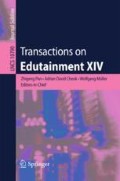Abstract
In order to inherit and develop the Couplet culture, one of the most famous language culture in China, this paper implements a creation system of couplets. In this paper, a noval way to generate the customized couplet is discussed from the name-embedded couplet. The 2-gram word graph technology is used to generate the first sentence which contained the given word. Then, combined with language model which based on statistical method, grammar model and mutual information model, improved Viterbi Algorithm based on HMM is used to decode the second sentence. It turned out that the system can realize the automatic generation of the name embedded couplet. According to the contents involved in the given couplet, the system can generate pictures to match the couplet. This system is aimed for Spring Festival couplets and Birthday couplets, both are name-embedded couplet that generated with the name of people. Users can choose the templates and relative special elements freely to create a satisfactory multimedia couplet picture.
Access this chapter
Tax calculation will be finalised at checkout
Purchases are for personal use only
References
Lutz, T.: Stochastische texte. Augenblick 4(1), 3–9 (1959)
Gervás, P.: Wasp: evaluation of different strategies for the automatic generation of Spanish verse. In: Proceedings of the AISB-00 Symposium on Creative & Cultural Aspects of AI, pp. 93–100 (2000)
Oliveira, H.R.G., Cardoso, F.A., Perreira, F.C.: Tra-La Lyrics: an approach to generate text based on rhythm. In: Proceedings of the Fourth International Joint Workshop on Computational Creativity (IJWCC 2007), pp. 47–54 (2007)
Wang, H.: Based on the examples of the machine translation-method and issue. Terminol. Stand. Inf. Technol. 3(2), 33–36 (2003)
Somers, H.: Review article: example-based machine translation. Mach. Transl. 14(2), 113–157 (1999)
Wu, Y., Zhao, J., Xu, B.: Chinese named entity recognition combining a statistical model with human knowledge. In: The Workshop on Multilingual and Mixed-language Named Entity Recognition: Combining Statistical and Symbolic Models (ACL 2003), Sapporo, Japan, pp. 65–72 (2003)
Liu, Y., Yu, S., Sun, Q.: The realization of computer support poetry research. J. Chin. Inf. 11(1), 27–35 (1996)
He, J., Zhou, M., Jiang, L.: Generating Chinese classical poems with statistical machine translation models. In: Proceedings of the Twenty-Sixth AAAI Conference on Artificial Intelligence, pp. 1650–1656. EB/OL. http://cls.hs.yzu.edu.tw/tang/PoemTone/index.asp
Zhang, Y., Jin, R., Zhou, Z.: Understanding bag-of-words model: a statistical framework. Int. J. Mach. Learn. Cybernet. 1(1–4), 43–52 (2010)
Hu, J.: The computer aided research work of Chinese ancient poems. Acta Sci. Nat. Univ. Pekin. 37(5), 727–733 (2001)
Genzel, D., Uszkoreit, J., Och, F.J.: “Poetic” statistical machine translation: rhyme and meter. In: Proceedings of the 2010 Conference on Empirical Methods in Natural Language Processing, pp. 158–166 (2010)
Jiang, L., Zhou, M.: Generating Chinese couplets using a statistical MT approach. In: Proceedings of the 22nd International Conference on Computational Linguistics (Colin 2008), vol. 1, pp. 377–384 (2008)
Fei, Y.: The Study of Multi-Layer Semantics of Chinese and the Design of Couplet System. Institution of Automation, CAS, Beijing (1999)
Yi, Y.: A Study on Style Identification and Chinese Couplet Responses Oriented Computer Aided Poetry Composing. Chongqing University, Chongqing (2005)
Bril, E.: Automatic grammar induction and parsing free text: a transformation-based approach. In: Proceedings of the ARPA Workshop on Human Language Technology, pp. 259–264 (1993)
Zhai, C.: Statistical language models for information retrieval a critical review. Found. Trends Inf. Retr. 2(3), 137–213 (2008)
Zhang, K., Xia, Y., Yu, H.: The method of adding punctuation and analysis sentence based on conditional random fields. J. Tsinghua Univ. 49(10), 163–166 (2009)
Yu, S.: Design and implementation of an automatic couplet answering system. J. Xiamen Technol. Univ. 19(1) (2011)
Jiang, R.: Computer assisted Chinese poetry and couplet generation. Zhejiang University (2011)
Apple. IOS System (EB/OL), 30 October 2013. http://www.apple.com.cn/ios/what-is/
Chen, J., Huang, G.: Construction strategy and main technology of the mobile library APP-take iOS for instance. New Technol. Libr. Inf. Serv. 9, 75–80 (2012)
Acknowledgements
This work was finished with the kind support of my formal students, they are Ruiying Jiang, Shunting Wang, Jing Guo and Wenda Fang.
Author information
Authors and Affiliations
Corresponding author
Editor information
Editors and Affiliations
Rights and permissions
Copyright information
© 2018 Springer-Verlag GmbH Germany
About this chapter
Cite this chapter
Pan, Z., Zhang, S., Guo, Y. (2018). EasyCouplet: Automatic Generation of Chinese Traditional Couplets. In: Pan, Z., Cheok, A., Müller, W. (eds) Transactions on Edutainment XIV. Lecture Notes in Computer Science(), vol 10790. Springer, Berlin, Heidelberg. https://doi.org/10.1007/978-3-662-56689-3_10
Download citation
DOI: https://doi.org/10.1007/978-3-662-56689-3_10
Published:
Publisher Name: Springer, Berlin, Heidelberg
Print ISBN: 978-3-662-56688-6
Online ISBN: 978-3-662-56689-3
eBook Packages: Computer ScienceComputer Science (R0)

